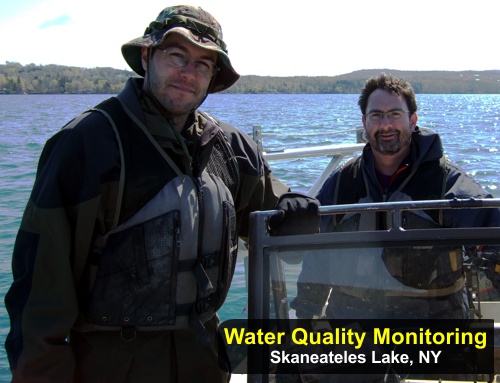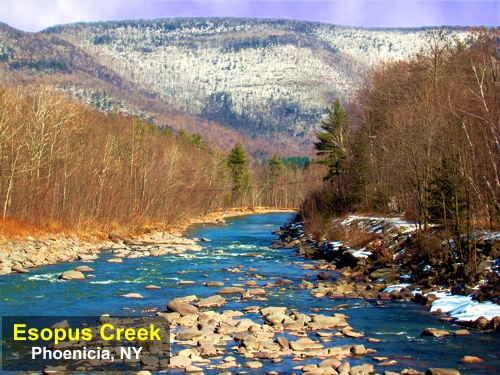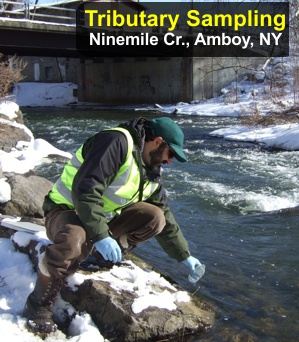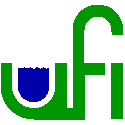Selected Projects
- Citizens Statewide Lake Assessment Program (CSLAP)
Since 2002, UFI’s water quality laboratory has been the certified laboratory for CSLAP samples. Started in 1985, the Citizens Statewide Lake Assessment Program (CSLAP) is a volunteer lake monitoring and education program managed jointly by NYS DEC and New York State Federation of Lake Associations (NYSFOLA). More than 1,500 volunteers and over 240 lakes have participated in the program. Each year, trained volunteers conduct monthly sampling on over 100 lakes. . A typical sampling cycle consists of
- sample collect by trained volunteer
- sample cooler shipped or delivered to UFI laboratory
- chain of custody logged into database
- request analyses conducted
- determine if additional analyses or archiving is indicated (e.g., possible harmful algae)
- restock sampler cooler and return to volunteers
- data report to DEC
.
- NASA Research Opportunities in Space and Earth Sciences (ROSES)
This NASA ROSES 2012 grant (first funded in 2014 due to sequestration) attempts to improving the link between optical and biogeochemical properties with application to remote sensing of water quality. The overarching goal of this project is to improve remote sensing retrieval capabilities for biogeochemical parameters for the inland waters of North America through physics-based approaches. Specific goals of this project include:
- Develop sets of mass-specific optical properties for important biogeochemical cases and lake systems, based on analyses of existing robust optics data sets, and new data collected from targeted surveys
- Develop a Lookup Table system to guide specifications of mass-specific optical properties for retrievals, based on biogeochemical cases
- Test and refine physics-based algorithm retrievals by implementing a Lookup Table system
- Apply the algorithms to decadal satellite (e.g., SeaWiFS, MODIS) imagery data to resolve and evaluate trends in water quality characteristic.
- Quantify uncertainty of retrievals through error propagation
We will address the following research questions:
- How do mass-specific optical properties vary in freshwater systems temporally, within and between lakes? To what degree can accounting for their variability reduce uncertainty in satellite retrieval of inherent optical properties and optically active constituents?
- How variable are backscattering spectra of particulates in inland waters? How can minerogenic and organic particulate components be best modeled for improved satellite retrieval?

- Onondaga Lake Ambient Monitoring Program Report
UFI provides services to Onondaga County Water Environment Protect to assist in their Ambient Monitoring Program and regulatory reporting requirements. The general elements of UFI’s services include:
- program support to County staff for AMP water quality program design and implementation
- quality control auditing
- technical assistance in the preparation of the Annual AMP Report, including effective integration of the data findings of the water quality and biological monitoring programs
- compilation of Annual AMP Reports
- attendance at meetings with regulatory personnel related to the AMP and with the Onondaga Lake Technical Advisory Committee (OLTAC)

- NYC DEP Operations Support Tool and NRT Montoring
Since 1994, UFI has been providing assistance to the New York City Department of Environmental Protection to study the City’s drinking supply reservoirs. UFI’s most recent projects include collaborating on the development of the recently implemented Operations Support Tool (OST) that is assisting in reservoir operations to meet both quantity and quality needs of City and downstream stakeholders. UFI’s hydrodynamic and turbidity models were integrated with a water budget model and utilizing inputs from near-real-time (NRT) autonomous sampling systems along with precipitations forecasts allow managers to test operating scenarios. In support of the OST, UFI developed a NRT network of autonomous fixed-depth and profiling buoys, and creek-side monitoring stations that provide current conditions to the managers and the OST’s water quality models..

- Cayuga Lake studies to support preparation of a Phosphorus TMDL
UFI has been critically involved in monitoring the southern portion of Cayuga Lake for Cornell University since 1998, related to their Lake Source Cooling (LSC) facility. The LSC supports much of the air conditioning needs of the campus utilizing the cold deep waters of the lake. Beginning in 2013, UFI is conducting a lake-wide study for Cornell to develop a phosphorus/eutrophication model that will serve to support a “total maximum daily load” (TMDL) analysis for phosphorus for the lake. This is an interdisciplinary study that includes components of
- Monitoring and Process studies
- Analysis of the data
- Development and testing of a model
UFI has conducted an intensive field campaign, monitoring of the entire lake and key tributaries and inflows. Data analyses and development and testing of the transport submodel are underway with water quality modeling to follow in 2015. UFI routinely brief regulators, review committees, and local stakeholders on progress and important findings, and is publishing related papers in peer-reviewed journals.

- Onondaga Lake Nitrate Addition and Monitoring
UFI has developed and is collaborated on the full scale implementation of a process to prevent the mobilization of methyl mercury (Hg) from the deep mercury contaminated sediments of Onondaga Lake. The strategy involves the addition of a nitrate solution into the bottom waters of the lake during the mid-summer to fall interval. The strategy has been found to perform well in preventing the mobilization of methyl Hg and has resulted in the reduction of mercury in fish flesh. As part of this program, UFI conducts detailed monitoring of the lake.
- Frequent monitoring of water quality
- Automated near-real-time monitoring program, see NRT
- Spatially intensive profiling of nitrate with leading edge rapid profiling instruments
- Monitoring of the nitrate addition to provide real-time recommendations for adjusting deployment depth
UFI collaborate in the interpretation of data sets that are the basis of evaluation of the effectiveness of treatment, and has published related article in peer-reviewed journals.

- Great Lakes
 UFI has participated in Great Lakes research cruises on all five Great Lakes that focused on remote sensing, harmful algal blooms, and general water quality. UFI’s primary goals are to provide optical measurement support to NOAA and the Naval Research Laboratory (NRL) to enhance remote sensing capabilities of the surface waters of the Great Lakes. Secondary goals are to advance mechanistic approaches for bio-optical modeling and related remote sensing capabilities. UFI has published 10 papers in the Journal of Great Lakes Research based on this work
UFI has participated in Great Lakes research cruises on all five Great Lakes that focused on remote sensing, harmful algal blooms, and general water quality. UFI’s primary goals are to provide optical measurement support to NOAA and the Naval Research Laboratory (NRL) to enhance remote sensing capabilities of the surface waters of the Great Lakes. Secondary goals are to advance mechanistic approaches for bio-optical modeling and related remote sensing capabilities. UFI has published 10 papers in the Journal of Great Lakes Research based on this work - Finger Lakes
 The Upstate Freshwater Institute (UFI) is also dedicated to the protection of the Finger Lakes, as well as the other freshwaters of the state. UFI has been involved in studies of the Finger Lakes, with particular emphasis on the eastern lakes, for twenty years (15 peer-reviewed publications and 26 reports). The Institute has been under contract with Cornell University since 1998, monitoring the impact of the Lake Source Cooling facility, and is presently developing water quality models for the lake to support a TMDL analysis. In 1996, and again in 2005, UFI conducted comprehensive monitoring campaigns of all of the Finger Lakes. These were demanding efforts that have not been undertaken or duplicated by any other entity. Further, these efforts adopted modern instrumentation and methods not previously applied to these systems. Such a holistic unified program has not been conducted on these lakes for more than 30 years. This work was unfunded. The information collected by UFI in these efforts is making valuable contributions to the understanding of these lakes and assessment of their water quality status. In addition, UFI conducts a lake-wide monitoring program on Skaneateles Lake, Syracuse’s unfiltered water supply.
The Upstate Freshwater Institute (UFI) is also dedicated to the protection of the Finger Lakes, as well as the other freshwaters of the state. UFI has been involved in studies of the Finger Lakes, with particular emphasis on the eastern lakes, for twenty years (15 peer-reviewed publications and 26 reports). The Institute has been under contract with Cornell University since 1998, monitoring the impact of the Lake Source Cooling facility, and is presently developing water quality models for the lake to support a TMDL analysis. In 1996, and again in 2005, UFI conducted comprehensive monitoring campaigns of all of the Finger Lakes. These were demanding efforts that have not been undertaken or duplicated by any other entity. Further, these efforts adopted modern instrumentation and methods not previously applied to these systems. Such a holistic unified program has not been conducted on these lakes for more than 30 years. This work was unfunded. The information collected by UFI in these efforts is making valuable contributions to the understanding of these lakes and assessment of their water quality status. In addition, UFI conducts a lake-wide monitoring program on Skaneateles Lake, Syracuse’s unfiltered water supply. - New York City Water Supply
 Since 1994, UFI has been providing assistance to the New York City Department of Environmental Protection to study the City’s drinking supply reservoirs. The City’s water supply, consisting of 19 reservoirs, is located north of the City. The nation’s largest unfiltered water supply provides water to over 8 million people. UFI’s involvement included intensive water quality monitoring, process studies, development and deployment of autonomous monitoring platforms, the development and application of water quality models and publications.
Since 1994, UFI has been providing assistance to the New York City Department of Environmental Protection to study the City’s drinking supply reservoirs. The City’s water supply, consisting of 19 reservoirs, is located north of the City. The nation’s largest unfiltered water supply provides water to over 8 million people. UFI’s involvement included intensive water quality monitoring, process studies, development and deployment of autonomous monitoring platforms, the development and application of water quality models and publications.- UFI first deployed autonomous monitoring platforms as part of process studies in 2001. Presently these systems provide crucial NRT data to DEP’s new Operations Support Tool (OST) which was developed recently with UFI collaboration.
- UFI has developed 1- and 2-D eutrophication models for all the West of Hudson reservoirs and selected East of Hudson Reservoirs. Additionally, UFI has developed 3-D hydrothermal models for selected regions of several of the reservoirs. UFI’s turbidity model is an integral part of the OST.
- UFI has published over 55 articles in peer-reviewed journals on research conducted on the New York City reservoir.
- Onondaga Lake and Tributaries
The Upstate Freshwater Institute has been conducting research on Onondaga Lake for more than thirty years. This work has resulted in the publication of a book summarizing studies conducted on Onondaga Lake. Additionally, UFI has prepared over 100 manuscripts on a wide range of topics concerning Onondaga Lake's ecology and water quality for publication in peer-reviewed science and engineering journals (including a journal issue devoted entirely to Onondaga Lake). UFI has an on-going comprehensive monitoring program for the lake, its tributaries, and adjoining portions of the Seneca River. UFI has developed, tested, and applied a number of mechanistic models for Onondaga Lake to support management action and related research; these include hydrodynamic/transport, water quality, and optics models. Mass balance models for the lake simulate chloride, fecal coliform bacteria, total phosphorus, nitrogen species, and dissolved oxygen. Several of these models have been formally approved by the State of New York and used to evaluate management options. The modeling program for Onondaga Lake is ongoing; models continue to be tested and modified based on new monitoring data. The goals of the program are to improve the credibility and capability of these invaluable management tools. Further, these frameworks are valuable research tools, used in the synthesis of interdisciplinary data and testing of hypotheses.

Selected Systems Studied
 UFI operates on grants and contacts from a broad range of sources including
UFI operates on grants and contacts from a broad range of sources including
- New York City Department of Environmental Protect (DEP)
- National Aeronautics and Space Administration (NASA)
- United States Environmental Protection Agency (EPA)
- Naval Research Laboratory (NRL)
- Honeywell, Inc
- Onondaga County Department of Water Environment Protection (WEP)
- New York State Department of Environmental Protection (NYS DEP)
In support of these projects, UFI has studied a large number of systems including:
- Many lakes and tributaries in New York State
- Laurentian Great Lakes
- New York City Reservoirs and tributaries
- Numerous other lakes outside New York State
Projects and Systems Studied
Upstate Freshwater Institute (UFI) is a not-for-profit [501 (C) (3)] research corporation (established in 1981) dedicated to the improvement of water quality and the advancement of freshwater research. We are a NELAC/NELAP accredited laboratory (NY Laboratory ID No. 11462, EPA Laboratory Code NY01276) since 1994.

224 Midler Park Dr
Syracuse, NY 13206
Fax: 315-431-4969
Phone: 315-431-4962
UFI does not discriminate on the basis of race, color, national origin, sex, age, disability or religion in our workplace, our programs, or our community activities.









